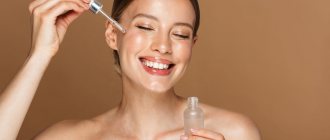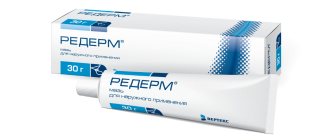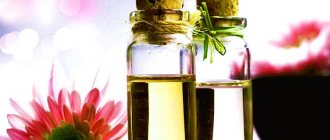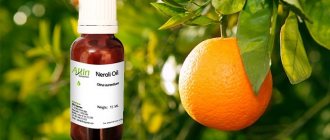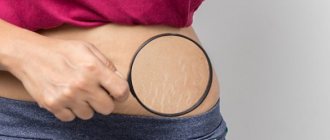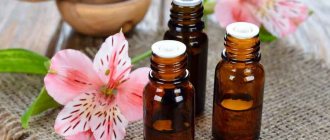This term comes from the word “comedone”. This is the name given to blackheads that spoil the complexion and appearance of the skin, and in advanced cases lead to the appearance of acne. They appear in both adolescents and adults - age does not matter here. To understand how blackheads arise, you need to get acquainted with the structure of the hair follicle.
Follicle is a depression on the surface of the epidermis within which hairs develop. In the lumen of the cavity, the sebaceous glands produce sebum, which lubricates the hair. When this duct becomes blocked, comedones form. If a favorable environment is created, they become inflamed and acne appears.
In adolescence, this is facilitated by increased production of sebum due to hormonal changes. In adults, in addition to disorders in the body, the problem is caused by incorrectly selected cosmetics, including vegetable oils.
Vitamins A and E can aggravate the condition of oily skin.
But not all oils are equally dangerous. The fact is that some of them are highly comedogenic, while others can be used to treat oily, inflamed skin.
Oils are 95% fatty acids, the presence of which explains why pores become clogged and sebaceous plugs form. Fatty acids are divided into three types - saturated, monounsaturated, polyunsaturated.
- Saturated fatty acids are thickeners, including in relation to sebum. But such substances are useful for dry, dehydrated skin, as they soften and prevent moisture evaporation.
- Oils with monounsaturated fatty acids are light, do not leave shine and penetrate into the deep layers of the skin, transporting beneficial substances there. It is believed that such products not only do not clog pores, but even dissolve sebaceous plugs, making the face cleaner.
- If polyunsaturated fatty acids predominate in the product, then they also penetrate well deep into the dermis, helping to maintain the fat barrier. But the disadvantage of these products is that they oxidize quickly and pose certain risks for oily skin.
Cosmetologists agreed that comedogenicity would be assessed using a five-point system. The table of comedogenicity of oils in Russian will tell you what score was assigned to a particular product.
These figures may fluctuate as they are affected by the degree of purification of the product. Thus, as a result of refining, the risk is reduced.
Comedogenic scale and basic concepts
The scale ranks the likelihood that any specific ingredients, such as natural oils used in a cosmetic product's formulation, will clog pores. Anyone who is susceptible to pimples and blackheads should avoid the most comedogenic oils, as they can cause ongoing acne problems. However, people with drier skin may prefer an emollient oil that falls closer to the middle of the scale.
What else is useful to know about oils?
— Oils, like any natural product, can cause allergic reactions. Or you may discover an individual intolerance to certain components of the oil; — When buying pure oil, especially from the budget segment, you can never be 100% sure that it does not contain impurities that can cause not only allergies, but also serious problems with the scalp; — Pure oils are incompatible with hot styling, since vegetable oil simply burns under high heat. In addition to the unpleasant smell, it turns out that you are literally “frying” your hair; — Oil can remove dye and, therefore, wash out the color of dyed hair. To avoid this, you should not use oils both after and two weeks before coloring.
The scale uses a numbering system from 0 to 5. Here's how the numbers are ranked on the scale
- 0 - will not clog pores at all.
- 1 - very low probability of pore clogging.
- 2—moderately low probability.
- 3—moderate probability.
- 4 is a fairly high probability.
- 5 - high probability of clogged pores.
Non-comedogenic oils are oils that do not clog pores and have a comedogenic rating of 2 or less. Almost any oil with a rating of 5 will guarantee that a person who is prone to acne will have this rating.
But there are still many other factors that influence how a particular oil will affect your skin, so there is no 100% way to make an “absolute” prediction. The fact is that everyone's skin is different, so oil affects people differently. For example, avocado oil may be nourishing for some people with oily skin, while others who also have oily skin will use it and get even more acne!
Factors that can lead to such a wide range of treatment results include: skin type, medical conditions, water intake, environmental influences and other things that can affect how oils affect your skin. In addition to the comedogenic ranking, the fatty acid chart is also useful for determining which skin type benefits from a particular oil.
Beauty myths. Part 8: killer car bronzers and other horrors
Are auto bronzers so harmful, why are we afraid of mineral oils, and why do creams clog pores? Cosmetologist Tiina Orasmäe-Meder and the beauty insider blog continue their unequal battle with the most enduring beauty myths.
Myth No. 1: “Auto-bronzants are just terrible chemicals. I'd rather sunburn myself. It’s more natural”
Tiina's opinion: “The main ingredient of all auto-bronzants is dihydroxyacetone, DHA. Despite the terrible name, which contains the even more terrible word “acetone,” it is, in fact, sugar obtained from chestnut peels. If you pick up a freshly fallen chestnut from the ground on Khreshchatyk in Kyiv or somewhere in Paris and peel it, your hands will darken. And it is the same substance that is included in auto bronzers that will color them. Now, however, chestnuts are not necessarily added there; there are other sources, but initially it was chestnut peel extract.
What happens when we apply this sugar to the skin as part of an auto-bronzant?
It reacts with the amino acids of keratinocytes. A series of reactions occurs - condensation, removal of liquid and, finally, a new molecule is obtained. It is already pigmented, that is, colored, and remains so until it exfoliates along with keratinocytes naturally - or with the help of a scrub.
All this is absolutely safe. The only downside is that in the process of creating this new molecule, the liquid evaporates. And as a result of constant use of auto-bronzants, the skin can become dry.
There are two ways of salvation here.
The first is to choose products that include powerful moisturizing ingredients. For example, Lancaster auto bronzers are impeccably made from this point of view. There the risk of dehydration is minimized.
The second is to not bother looking for advanced auto-bronzers, use the ones you like, and after application, wait an hour and a half, use a moisturizer. It will “catch” and seal the escaping water.
If you use auto-bronzant on your face, the scheme is the same. Just don’t wait an hour, apply a hyaluronic acid-based moisturizing concentrate after 30 minutes. There is no need to be afraid that after auto-bronzant it will not penetrate deeper. Auto-bronzants do not prevent anyone from getting to the final point of the route :) DHA is a small molecule, it is not an obstacle to hyaluronic acid molecules.
And another interesting point: for fair-skinned girls, in order to get a beautiful, even tan using a bronzer, you need to choose those with a DHA concentration of at least 5%. And for dark skin, 1.5% is enough. It would seem logical to assume that, on the contrary, dark-skinned people need a “darker” bronzer. But in fact, the amino acids of keratinocytes of dark skin stain faster. True, the concentration of DHA is not written on the packages. So you can only find “your” auto-bronzant through experience.
This is what the auto bronzer shade is all about. How it will lie - evenly or in spots - depends on a million factors. The same remedy will work completely differently for two different people. Because they, for example, have a different number of cells in the upper stratum corneum of the skin. And the number of these cells depends, for example, on age (the older you are, the more, and the less evenly the tan will lie). Further: if the skin itself is dry, then it will lie worse and will be more orange in color. Next up: your lipid mantle. In general, it is individual for everyone, like a fingerprint. DHA penetrates evenly through one mantle, and in patches through the other. It's impossible to predict.
“Darling, I haven’t left the bath for five days. What do you mean - what am I doing there?! I’m applying auto-bronzant!”
In general, with self-tanners the “I read it on a blog, it was recommended by a friend, I went to buy it” method works even less than in any other cases.
And the “anti-scientific poking” technique, on the contrary, triumphs. Do you want to have tanned legs without getting sunburned? Try, try, try.
By the way, you can (and should) try it in the store. Apply the product to the inside of your shoulder and, just in case, to your elbow. You can make several smears from different jars. And go home - nothing will show up in the store anyway. Assess the situation in a couple of hours. Just don’t get confused about which product is which.
Another difficulty in choosing the ideal auto-bronzer: the condition of the lipid mantle and other skin characteristics are not constant. In winter one thing, in spring another, in summer – third, at 25 – fifth, at 30 – tenth. It matters whether you have been tanned or not (and some people like to “polish” auto-bronzant on tanned skin to “deepen and complement”). Body temperature is generally one of the decisive factors. Even tenths of degrees will change the whole picture: DHA is very sensitive to temperature. Therefore, by the way, auto-bronzant should not be applied after a hot shower. It will “sink” into your pores, and instead of tanning, you will get orange spots. Although, of course, the new generation of self-tanners are much more advanced. They have a fundamentally different texture, which contains silicone. And it ensures more or less uniform spreading.
In general, the ideal scheme is this: try it in a store; choose the one that suits you before purchasing; do peeling the day before (not immediately before application! Otherwise, the skin will become warmer, and the auto-bronzant will go deeper than necessary, and the shade will be unnatural); Apply the product to a dry body.
If all this does not help, and the auto-bronzant still remains stained, peeling is the only way to get rid of it as quickly as possible.
I myself have loved one product for many years - Bronz'Express from Académie. It is liquid and not very comfortable, but if you mix it with moisturizer, it applies perfectly. At least on my body. I suspect Clarins facial bronzer is made using the same scheme, which should be added to the cream. Due to the fact that the bronzer is yellow and the cream is white, you can see how well you mixed it and whether you got the desired uniform color.
And one last thing. If you apply self-concealing bronzer before going to the beach for the first time, remember that you still need to apply SPF cream on top. But first, let a couple of hours pass for your amino acids to properly absorb the DHA.”
Myth No. 2: “It’s the cream’s fault that my pores are clogged. I'll give it to my beloved friend. Let men not love her either!”
Tiina's opinion: “What exactly are “clogged pores”? These are comedones, closed or open, that is, all the same dead cells, keratinocytes, which are saturated with sebum, which, in turn, oxidizes and turns into a blackhead. Or, if there is a skin “hood” on top – in white.
In order for the cream to “clog” the pores, you need to have certain prerequisites. Firstly, loose skin. Secondly, open sebaceous glands with a wide mouth. Thirdly (which stems from “secondly”) - it is necessary that the top layer of skin is already injured, and the keratinocyte scales stand like tiles, with the ribs up. That is, if something clogs your pores, treat your skin. All the ingredients discussed below are simply a catalyst, the last drop to clog pores and form comedones.
In the world of cosmetology, Tiina Orasmäe-Meder is known as a most competent professional, and online – as a “personality with territory” (that’s the name of her famous LiveJournal blog). You can learn more about the Meder Beauty Science line of care products on the brand’s website.
Yes, using cosmetics with so-called comedogenic ingredients can worsen the situation. First of all, animal fats contribute to this. They are viscous, dense and easily penetrate into enlarged pores. Therefore, protecting yourself from frost with lard is, let’s say, not the best way.
True, now animal fats are used quite rarely in creams. But often - mineral oils. They also play the role of a plug that clogs open pores.
Below is a list of other ingredients that can clog pores:
— isopropyls and isosteoryls (a pretty good emulsifier, by the way);
- all derivatives of lanolin (although it is pleasant, soft, gives the skin a well-groomed appearance and is often used, especially in inexpensive cosmetics);
— coconut oil (yes, that natural one that we love so much!);
- peach seed oil, also wonderful and also natural. The trick here is that it contains oleic acid, which is also called an icebreaker: it falls through the epidermal layers and quickly dissolves the lipids that connect the cells of the upper layers of the epidermis. And at the same time it contributes to clogging of pores;
- sweet almond oil.
Silicones and dimethicones, which many are afraid of, are not comedogenic. They do not penetrate inside, but simply create a film on the surface of the skin.
So if you have acne-prone skin, read labels for the above products and, if possible, grab a sample. In your case, they will definitely help: comedogenicity will manifest itself in two or three applications.”
Myth No. 3: “Mineral oils are a terrible evil. They don’t exist in our body, and attempts to introduce them there will definitely backfire!”
“I only paint oil paintings! What are you doing, right in his face, right?!”
Tiina’s opinion: “The main thing people don’t like about mineral oils is that they are not natural. In general, the cliche “everything natural is wonderful, everything unnatural is terrible” is embedded so deeply in our subconscious that it is difficult to uproot it from there. In fact, “unnaturalness” is not always a grave sin. It is important to understand why mineral oil is added to the product and what problems this product solves.
What do mineral oils do in the first place? They, like silicones, create a tight-fitting film on any surface.
If they are present in the lipstick, great, you will get perfect lips “without folds, wrinkles or cracks.”
If a beach cream with physical filters has SPF protection, great. Physical filters do not interact with oils. Oils prevent filters from penetrating the skin. Accordingly, the protection period increases indefinitely. And such drugs on the beach are, by definition, more effective.
The same film that mineral oils create can be a lifesaver for dry and damaged skin. The evaporation of liquid decreases sharply, and the skin under the film slowly begins to recover and repair itself. For this reason, the most prominent representative of mineral oils, Vaseline, has been successfully used by dermatologists for a long time.
And finally, mineral oils are much less likely to cause allergies than vegetable oils, which most of us are so fond of.
The disadvantages of mineral oils - in addition to the comedogenicity described above - are that, for example, you cannot massage with them. During massage and any other mechanical procedures, mineral oil still penetrates—more precisely, it is driven in and absorbed into the dermis. And there, strictly speaking, he has nothing to do, and therefore not only comedones, but also inflammatory reactions and acne can occur. So it is better not to massage creams with mineral oils into your face using massaging movements (especially energetic ones).
Otherwise, when used correctly, mineral oils are not evil. And they are so not evil that they are used in children’s cosmetics, such as Johnson & Johnson.”
Dear ones, previous myth debunkings can be found under the tag “Beauty Myths”.
If you know any other myths, as always, welcome in the comments. We'll definitely sort everything out. Write - just please read those that have already been said first, so as not to repeat yourself.
Fatty acids: main components in oils
Fatty acids such as omega-3 and omega-6 are key to healthy skin. This applies not only to foods rich in these fatty acids, but also to foods containing them. In fact, research has shown that symptoms of essential fatty acid deficiency can be reversed by eating foods rich in linoleic acid.
Supplementing with linoleic acids may actually be more effective than consuming fatty acids when it comes to skin health. Many fatty acids that enter the body tend to be oxidized in the liver before reaching the skin.
Regardless of your skin type, essential fatty acids are important for health, even if you are not deficient in them.
It is well known that overexposure to ultraviolet radiation can cause skin cell damage, including inflammation, as well as suppression of the immune system in the skin itself. Premature aging results from the breakdown of collagen in skin cells and causes loss of elasticity, leading to wrinkles. Fatty acids in foods help protect and may even help eliminate these harmful effects.
Other substances
When buying ready-made cosmetics or planning to prepare a cream at home, you should keep in mind that in addition to vegetable oils, other fats are also used .
They, in turn, can also worsen the condition of the skin, especially if it is oily and has acne.
| Drug name | Point |
| Petrolatum | 0 |
| Ceresin wax | 0 |
| Mineral | 0 |
| Candelilla wax | 1 |
| Carnauba wax | 1 |
| Beeswax | 2 |
| Emulsion wax | 2 |
| Shark liver oil | 3 |
| Lanolin | 3 |
| Mink oil | 3 |
Studies have shown that blackheads on the face also appear from the following components:
- isopryl palmate;
- isopryl isostearate;
- sodium lauryl sulfate;
- hexadecyl alcohol;
- isostearyl neopentanoate;
- isopropyl myristate;
- isocetyl stearate;
- butyl stearate;
- Decyloleate.
What types of fatty acids are the best?
Vegetable and seed oils contain two types of fatty acids - linoleic acid and oleic acid.
Alpha-linoleic acid (omega-3) and linoleic acid (omega-6) are considered “essential fatty acids” because the body cannot produce them on its own. Oleic acid is produced by the body, so it is not considered “essential”.
Knowing the difference between fatty acids and how they interact with the skin will help you choose the most effective product based on your skin type.
Oils with linoleic acid
Research has shown that people with acne have low levels of linoleic acid in lipids on the skin's surface. Adding oils rich in fatty acids is the best way to solve this problem.
Linoleic acid is an essential omega-6 fatty acid that is not produced by the body. It has anti-aging, barrier, protective, soothing and balancing properties and is most suitable for oily and acne-prone skin.
The highest ratios of linoleic acid are found in black cumin, evening primrose, hemp, grape, guava seed, passion fruit, red raspberry, rose hip, safflower, sunflower, soybean and wheat germ oil. Borage, castor, cherry, chia, kiwi, pomegranate and sesame oils contain high amounts of linoleic acid, but have a more balanced profile.
The highest ratios of oleic acid are found in almond, apricot, avocado, carrot, hazelnut, macadamia, macula, olive and palm seeds.
Brief table
Degrees
A scale from 0 to 5 has been developed to assess comedogenicity. Where zero is the lowest and safest value, and five is the highest. The index concerns only oils in their pure form. In the composition of cosmetics, the value can be reduced due to the correct combination of components. Therefore, when choosing a pure oil, it is imperative to focus on comedogenicity indicators, and when purchasing synthetic skin care products, in most cases it makes no sense to pay attention to this.
Zero and low
These include oil products with comedogenicity indices of 0 and 1. As a rule, they have a liquid consistency and are easily distributed over the surface of the skin. They are used to cleanse and nourish oily and acne-prone epidermis. Those with dry and normal skin types can also use these products in their pure form. Let's look at the most popular oils with a low comedogenic index.
Shea butter (karite) - 0
Rich in hyaluronic, linolenic, palmitic, linoleic, stearic acids, vitamins F, K, A, E, PP and C. Blood circulation increases in the area where the product is applied, which triggers rejuvenation processes. The production of natural collagen and elastin is activated, resulting in the skin becoming elastic. The oil relieves inflammation, intensively moisturizes the skin, removes toxins and kills bacteria, which most often cause skin problems. With its help you can get rid of age spots.
Hemp oil – 0
Nourishes and moisturizes the epidermis. It can be used even by allergy sufferers. Hemp extract softens the skin and actively combats dryness and flaking. With its help you can cleanse your face of toxins. The antiseptic effect of the product helps stop the spread of infection on the skin. In addition, hemp oil normalizes the secretion of sebaceous secretions; this effect is especially important for oily skin. With regular use, density and elasticity increases. A healthy and even complexion is guaranteed to you. Women 30+ are recommended to use the oil to prevent premature skin aging.
Argan oil – 0
This product is especially appreciated by cosmetologists, manufacturers of care cosmetics and girls who like to prepare homemade remedies. Popularity remains despite the high cost. Contains a large amount of acids. Argan oil perfectly moisturizes the skin. Recommended for dry skin care. Regular use of the product slows down the aging process. The oil relieves inflammation, lightens age spots and evens out the complexion. It can be used as protection against the harmful effects of ultraviolet radiation.
Argan oil is hypoallergenic, so it is used to care for the skin of babies.
Mango butter - 0
The non-comedogenicity and other properties of the product allow it to be applied even to areas affected by acne. Mango extract is rich in vitamins C, A, E, D and members of group B, as well as micro- and macroelements: calcium, magnesium, potassium and others. The product moisturizes, nourishes, softens, heals, has an anti-inflammatory effect, and protects the skin from ultraviolet radiation. The skin after it becomes soft and elastic.
Rosehip oil – 1
Absolutely safe from a comedogenic point of view. It contains an extremely rare element - trenitoin, or trans-retinoic acid. Has high healing ability. It even fights the manifestations of eczema, dermatitis and psoriasis. Stabilizes sebum production and thereby cleanses the face of inflammation. Effective for dehydration, helps retain moisture and restores elasticity. Affects fine and deep wrinkles, eliminates peeling and irritation. It has a mild whitening effect and is effective against rosacea. For the body it is used to combat stretch marks.
Sea buckthorn oil – 1
Effectively fights wrinkles, relieves inflammation, disinfects the skin and improves regeneration processes. Sea buckthorn extract nourishes, moisturizes and evens out the complexion. This is a reliable remedy for peeling. Purulent inflammation disappears after the first use. If there are wounds on the face, the oil will help speed up the healing process. With regular use, you can forget about greasy shine. When performing a facial massage, it enhances the lifting effect. At the same time, it is non-comedogenic.
Ylang-ylang oil – 1
The components that make up the oil saturate cells with oxygen, enhance regeneration, and have a pronounced rejuvenating effect. The oil composition tightens pores and evens out skin tone, making it matte. Girls who are struggling with oily shine should definitely purchase this product. Non-comedogenic ylang-ylang oil is used to prevent acne.
Castor oil – 1
Works great on pimples and blackheads. Inflammation is relieved from the first use, and with regular use you can even remove acne marks. It has proven to be an effective remedy in the fight against wrinkles. A quick result can be obtained by using castor bean extract for crow's feet. Often used for scars and pigmentation.
Less popular types of oils with zero and low comedogenicity can be seen in the table.
| Safflower | 0 |
| Sunflower squeeze | 0 |
| Black cumin extract | 1 |
| Sesame | 1 |
| Pomegranate seed squeeze | 1 |
Moderate
This group is different in that the components can change their index depending on the user’s skin type and other factors. This means that for some they are suitable, but for others they cause irritation and blackheads. Let's look at the most popular oils and their properties.
Almond oil – 2
Has a nourishing and moisturizing effect. More suitable for dry skin as it can cause irritation and clog pores. Returns skin tone and slows down the aging process. Has an exfoliating and cleansing effect. It is used for allergic reactions to relieve itching and irritation. When applying oil, blood circulation in the affected area accelerates, which promotes better penetration of the components into the deeper layers. In summer you can use it instead of sunscreen.
Macadamia oil – 3
It should be used with caution on oily and inflamed skin to avoid unpleasant “surprises”. It contains many vitamins and minerals, as well as rare folate, which has a powerful anti-inflammatory effect. The extract normalizes blood microcirculation, prevents early aging, moisturizes the skin and normalizes water balance. Often used as protection against dryness and flaking of lips, elbows and heels.
Usually it is not used in its pure form, but is added to skin care products as one of the main components.
Olive oil – 3
It is actively used in food, however, it remains popular among lovers of home cosmetic procedures. Most often, nourishing masks are made with this product and added to moisturizers. Has protective properties. In summer, it is applied to the face shortly before going outside, as it filters harmful UV rays. In addition, the rich composition of the natural component saturates the skin with all the necessary elements to improve its condition.
This group also includes oils, which you can see in the table below.
| Avocado squeeze | 2 |
| Pumpkin | 2 |
| Sandalwood oil | 2 |
| Peach | 2 |
| Hazelnut extract | 2 |
| Vinogradnoye | 2 |
| Apricot kernel squeeze | 2 |
| Soy | 3 |
| Sesame | 3 |
| Corn | 3 |
High
These oils are also used in skin care, but usually as part of other products, or applied pointwise to areas where comedones cannot form. Most representatives of this group have proven themselves as hair care products. For the face they should be used with great caution. The cosmetic effect of them is good, but in most cases, using them in their pure form is more problematic than it is beneficial. Let's look at two prominent representatives of comedogenic oils.
Coconut oil – 4
This product is recommended to be used as a night moisturizer. However, it should not be used by girls with oily and problematic skin. The high comedogenicity of the oil guarantees an increase in inflammation. The opinions of those who have used the product on their facial skin vary. Some found salvation in it from flaking, dryness and dehydration. Others have developed clogged pores, allergies and other problems. Therefore, it is recommended to carry out a test on a small area to assess the risks, but it is better to use coconut extract as an addition to the main products. It is also suitable for hair restoration, but it is prohibited to smear the scalp.
Cocoa butter – 4
This is the strongest remedy against premature aging. It is hypoallergenic. This component protects the skin from negative influences. However, its high comedogenicity does not allow it to be used by everyone. It is suitable only for some female representatives. We recommend testing before use by applying oil to a small area of skin. If no reaction occurs, then you are one of the lucky ones who can experience the positive effects of this product.
Below is a table of oils with a high comedogenic index.
| Linen | 4 |
| Palm | 4 |
| Wheat germ | 5 |
Be extremely careful when using them!
Clogged Pores - What You Should Know
Now that we've discussed how comedogenic oils clog pores, let's look at how it all affects your skin overall. The main result of clogged pores is pimples. But instead of trying to treat pimples when they happen, let's look at how to prevent them from happening in the first place.
Clogged pores or comedones lead to the development of a whitehead or blackhead, which is the result of skin inflammation. Clogged pores cause the development of acne, which occurs when the skin's sebaceous glands begin to secrete oil.
It usually occurs during puberty and is often caused by hormones. Dead skin cells that the body normally removes can also cause clogged pores.
Interesting: Clogged pores can negatively affect your skin even after the pimple has disappeared and the acne has been eliminated. When pimples keep coming back, the pores can become enlarged, causing other pores to become clogged, leading to more blockage and breakouts.
Oily skin and its dangers
Oily skin is the best breeding ground for bacteria, which are found on all skin types. Adding comedogenic oils aggravates acne and slows down the clearing process on your face. Treating clogged pores and pimples is crucial because untreated pimples can lead to scarring.
Products containing oils that don't clog pores are good for people with oily skin. If you have oily skin, avoid oils that clog the pores on your face, such as coconut oil, wheat germ oil, and some other oils that are high in oleic fatty acids.
Oils that can be used if you have oily skin include: grapeseed oil, rosehip oil, primrose oil, jojoba oil and others high in linoleic fatty acid.
Trade names and prices of oils
Product prices:
- 100 ml “ROS” grape seed oil can be purchased for 150 rubles.
- Argan oil “Zeitun” in a volume of 10 ml is sold at a cost of 500 rubles.
- Safflower oil “Hemani” with a volume of 30 ml costs 300 rubles.
- Natura Botanica shea butter 30 ml costs about 400 rubles.
- Sea buckthorn oil “Organic Life” costs about 350 rubles.
- Rosehip oil “Oleos” with a volume of 30 ml has a price of 150 rubles.
- Apricot kernel oil “Cosmos” in a volume of 50 ml is sold at a price of 250 rubles.
Non-comedogenic oils are produced by various cosmetic brands, but pharmacy products are the safest for the face.
Using the oil comedogenicity table
One of the keys to determining which ingredients on the comedogenic scale to use for beautiful, healthy skin is knowing your skin type. There are five main skin types: normal, dry, oily, sensitive and combination.
Much of this ranking is subjective because there is no scientific classification of skin types. It is based on observation and subjective assessment. Since there are so many different types and needs, it's important to try different things and find what your skin prefers.
Use the products in the table for at least a month to evaluate your skin's reaction.
Conclusion
Always remember that any oil can cause an allergic reaction, so do a quick test before use. To do this, apply a small amount of natural oil to a sensitive area of the skin. For example, on the bend of the elbow or the inside of the wrist. Leave the product on for 15 minutes to an hour, if after this time there is no redness, itching or swelling, the oil can be used. Otherwise, wash off the product immediately.
Also, do not forget to consult doctors who can more accurately determine your skin type and select the ideal natural oil for it.
Normal skin type
- Normal skin is not particularly dry or oily.
- The pores are usually small, the skin does not shine, does not flake or crack. Typically there are a few wrinkles or lines.
- If you have normal skin, you should use products that do not strip the skin's natural oils, but moisturize, thereby helping to reduce wrinkles.
The best oils for normal skin include: argan oil, grape seed oil, hemp seed oil, jojoba oil, cherry seed oil.
Oils and hair loss
It is strictly forbidden to apply oils to the scalp during hair loss, since: 1. Oils soften the mouths of the hair follicles and hair easily leaves the follicles under mechanical influence (in other words, they are pulled out); 2. Oils need to be washed off. This process is quite difficult, involving intense mechanical stress, which is contraindicated for hair prone to hair loss.
Therefore, if you use oil, then only when there is no hair loss (for prevention) and no more than once a month.
Take the test and find out how to help your hair
Dry skin
Dry skin makes people feel tight, and the skin is often scaly and has flaky patches. People with dry skin have pores that are almost invisible. There are many factors that cause dry skin, from heredity and genetics to the amount of sebum produced in the skin.
If you have dry skin, you need to regularly moisturize it during your facial. You'll also need to avoid harsh cleansers, limit your time and frequency in hot showers, use a good humidifier in your home, and consider using products that contain humectants such as hyaluronic acid.
Should you use coconut oil for acne?
A product rich in polyphenols and phytonutrients has several beneficial properties for problem skin169:
- has an antimicrobial, antibacterial effect;
- normalizes the functioning of the sebaceous glands;
- accelerates the processes of regeneration of epidermal cells;
- prevents skin dehydration;
- protects skin from free radicals;
- improves complexion.
Coconut oil for acne-prone faces may be beneficial as it has a soothing effect. It can relieve inflammation and eliminate swelling.
Results
- The scale ranks the likelihood that any specific ingredients, such as natural oils used in a cosmetic product's formulation, will clog pores.
- The scale uses a numbering system from 0 to 5.
- Non-comedogenic oils are oils that do not clog pores and have a comedogenic rating of 2 or less. Almost any oil with a rating of 5 will guarantee that a person who is prone to acne will have this rating.
- In addition to the comedogenic ranking, the fatty acid chart is also useful for determining which skin type benefits from a particular oil.
Non-comedogenic facial oils
These are oils that are assigned 0&minus.1 points on the scale mentioned above. They are liquid, flowing, light and suitable for any skin type, including oily and problem skin. The following are non-comedogenic facial oils, the list also contains a score.
| View | Points |
| Shi | |
| Safflower | |
| Sunflower (refined/unrefined) | 0/1 |
| Mango | |
| Hemp | |
| Argan | |
| Rosehip | 1 |
| Black cumin | 1 |
| Sea buckthorn | 1 |
| Neem (margosa) | 1 |
| Refined sesame | 1 |
| Castor | 1 |
| Pomegranate seeds | 1 |
